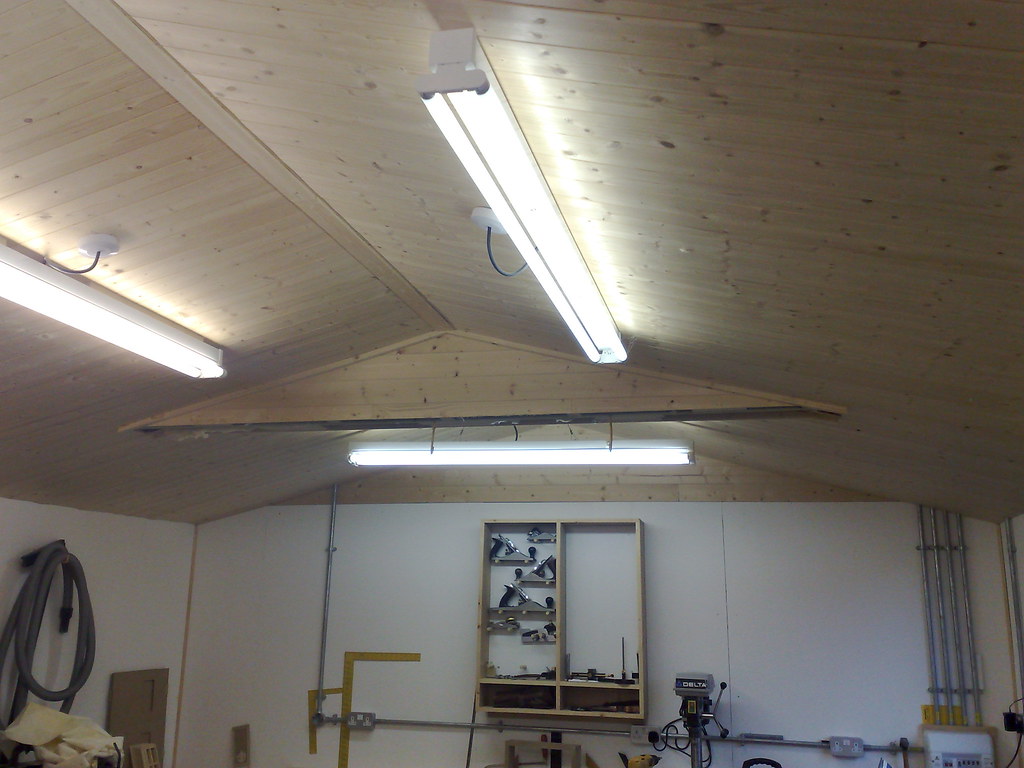High Frequency (‘HF’) fluorescent lighting is definitely worth considering.
In a nut shell, HF fittings are inherently more energy efficient, saving something like a quarter to a third (but don’t quote me!) because
a) the high frequency circuitry inside the fitting wastes less electricity as heat, and
b) tubes operated at high frequency emit more light [on a like for like power compared to traditional fluorescent fitting]. HF manufacturers generally aim to keep the light levels similar, so the HF fittings have their power turned down, hence consuming less electricity for the same light output.
Also, HF fittings have quite a few other advantages. As already pointed out, they prevent risk of strobing effects from moving machinery. Some other advantages are, they are flicker free to the eye, quick to start at switch on, operate without any mains hum, extend tube life, give off less heat (fighting the summer heat [ha ha] / air conditioners [again ha ha]).
Of course there is a trade off: they cost more to purchase! In summer 2008, wanting more light in my workshop, I upgraded my traditional fluorescent lighting (from 5 x 5ft singles) to HF fittings, (6 x Twin 5ft HF moisture resistant sealed fittings). I paid a local electrical distributer almost £300. These fittings are ‘moisture resistant’ so nicely sealed from dust, plus the tubes protected from breakage behind a full plastic diffuser.
Yes this is a lot of cash, but I've got 12 tubes fitted, running HF, and the light output is…tremendous!
Finally, if you have made it this far you are probably semi interested…so it’s also worth saying:
- Do not confuse ‘HF’ fittings with LP/LPF/HP/HPF fittings etc. They are not related.
- Screwfix item code 63625 are similar to my HF fittings, but SF is very very very expensive. Try gently haggling with the local electrical distributers, their prices can vary widely, but I always find ‘CEF’ to be consistently best price on cash sales. And check the boxes that they are really HF!
- Finally, if buying tubes, ask for ‘Tri-phosphor’ coated tubes. These dim a lot less with age, which is something I cannot say about myself!
 Anyway, one of the things that I have to address is lighting. I had 2x200watt bulbs wired into one ceiling rose, hanging at each end of the room. 800 watts total. It has been pointed out to me that this is none too safe! Fair point. My question is what to replace them with. I like to have a high level of general illumination in the workshop and ideally, something cheaper to run. Any ideas?
Anyway, one of the things that I have to address is lighting. I had 2x200watt bulbs wired into one ceiling rose, hanging at each end of the room. 800 watts total. It has been pointed out to me that this is none too safe! Fair point. My question is what to replace them with. I like to have a high level of general illumination in the workshop and ideally, something cheaper to run. Any ideas?




